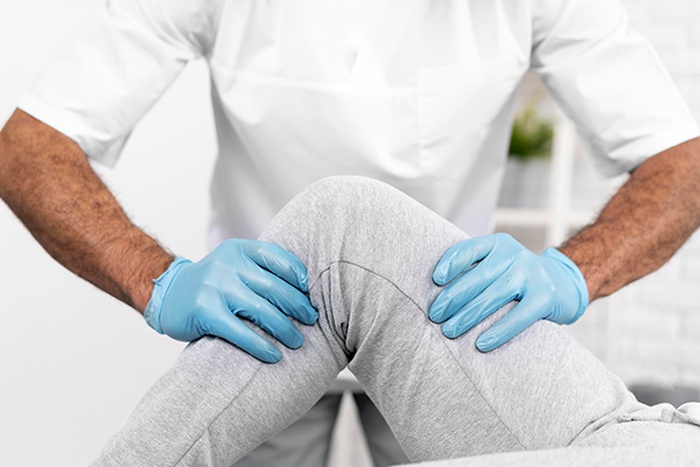
ANTERIOR CRUCIATE LIGAMENT(ACL)
The bone structure of the knee joint is: femur, tibia, and patella. Some part of these bones that makes the joint are covered with cartilage. Between femur and tibia there are two meniscus (medial and lateral) which act as shock absorbers. The ACL is one of the four main ligaments(ACL, PCL, MCL,LCL) within the knee that connect the femur to the tibia. ACL is one of the most commonly injured ligaments of the knee. The people who do the sports of basketball, football, skiing, have higher risk of injury of ACL.
Causes and Symptoms
ACL rupture is one of most common knee injuries. It especially happens by sudden trauma during sports activities such as football, basketball, ice hockey, and other sports such as skiing and tennis that cause knee rotation. The most common symptoms are pain and swelling, loss of full range of motion, tenderness around the knee and not walking comfortably.
Diagnose
To diagnose the ACL rupture an orthopaedics doctor should check the patient’s knee and get the patient history. Of course that will not be enough and the patient should be checked by MRI(Magnetic resonance imaging- best images of the soft tissues inside the knee, like meniscus, ACL, cartilage, ligaments etc) and X-ray (not to diagnosed the ACL rupture but to confirm the other reasons of knee pain such as fracture, osteoarthritis or loose body) to confirm the exact diagnose.
Treatment
The treatment of ACL injury depends on the patient's activity level, age of patient, degree of injury and degree of instability. Nearly half of patients who have ACL injury have some other injuries as torn meniscus, damage of cartilage, MCL(medial collateral ligament) injuries. With the chronic instability due to ACL injury that is not treated most of the patients will have torn meniscus and cartilage damage in 10 or more years after the initial injury.
Nonsurgical Treatment
Generally torn ACL needs operation except some specific conditions. These are:
- Inactive older patients
- Partial tears with no instability symptoms
- The patients who live sedentary life
- Children or adolescents whose growth plates are still open(The operation can delayed until to skeletal maturity or the ACL surgery technic may be modified to decrease the risk of growth plate injury.)
In nonsurgical treatment, progressive physical therapy and rehabilitation should be done to make the muscles strong around the knee to prevent instability. This may be supplemented with the use of a hinged knee brace especially during sport activities.
Surgical Treatment
The most common treatment for torn ACL is reconstruction with hamstring tendons, patellar tendon, quadriceps tendon graft (tissue that is taken from another part of the body) and allograft (taken from a cadaver). But depanding on the rupture and age of patient it also can be repaired with special stitches.
Surgical Procedure
Surgical procedure begins with arthroscopy to see the torn ACL. Then the graft(hamstring tendons, patellar tendon, quadriceps tendon) is taken and prepared to the correct size for the patient. In the most common ACL reconstruction technique, bone tunnels are drilled into the tibia and the femur to place the ACL graft in almost the same position as the torn ACL. The graft is held under tension as it is fixed in place using screws.
Rehabilitation
Physical therapy is a crucial part of successful ACL surgery, with exercises beginning immediately after the surgery. The goals for rehabilitation of ACL reconstruction include reducing knee swelling, regaining full range of motion of the knee, as well as strengthening the quadriceps and hamstring muscles. Partially weight bearing is allowed by crutches at the same day or the day after surgery and last for 7 to 10 days. The patient's sense of balance and control of the leg must also be restored through exercises designed to improve neuromuscular control. This usually takes 4 to 6 months.
Surgical Complications
Infection: The incidence of Infection after arthroscopic ACL reconstruction is very rare.
Numbness: It is common to have numbness on the outer part of the upper leg next to the incision in a small area, which may be temporary or permanent.
Blood clot: It is also rare, blood clot in the veins of the calf or thigh is a potentially life-threatening complication. A blood clot may break off in the bloodstream and travel to the lungs, causing pulmonary embolism.
Instability: Recurrent instability due to rupture or stretching of the reconstructed ligament or poor surgical technique is possible.
Stiffness: Knee stiffness or loss of motion has been reported by some patients after surgery. However, it is rare if the rehabilitation is done early after surgery.
Growth plate injury: In young children or adolescents with ACL tears, early ACL reconstruction creates a possible risk of growth plate injury. That is why the operation can be delayed until to skeletal maturity or the ACL surgery technique may be modified to decrease the risk of growth plate injury.
© COPYRIGHT 2025 ALL RIGHTS RESERVED
Privacy Policy